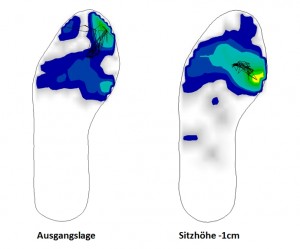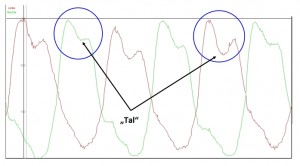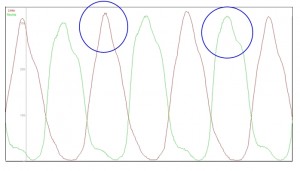Saddle height and force transmission – a direction relation!
Having considered the point of contact saddle and possible problems related to it in the first blog on saddle height, I would now like to focus on the relation between saddle height and force transmission. In this regard, the chain foot – ankle – knee – hip is decisive. Especially the positioning of the feet deserves our attention: Every athlete has the possibility to compensate for sitting too high during the pushing phase by actively pulling up the heel. This compensatory movement reduces the stretching of the hamstrings and is especially common among riders with a low muscular flexibility. What are the consequences of this larger foot angle for the force transmission to the pedal?
As we can see in the pressure figure on the left-hand side, most of the pressure is on the toes and the front part of the ball. This means the foot is pointed during the pushing phase of the pedal stroke. The toes are not the strongest part of the foot and the considerably stronger structure of the ball (especially the big toe joint) remains unused. When reducing the saddle height (right-hand figure), the pressure is moved to the ball of the foot and especially to the inner part of the big toe joint. The pattern of the central pressure point (represented by the black line) is more stable in the right figure. By sitting too high, the heel’s range of motion (upwards – downwards) is significantly restricted. Accordingly, the heel cannot be actively used to support the forefoot. In addition, pedaling with a pointed foot means that only a fraction of the pushing phase force is applied in the ideal pedaling direction. This becomes visible when analyzing the force-time-plots:
The peaks of the curves represent the pushing phase of the left and right leg, respectively. It is visible that a ‘valley’ divides each of the peaks into two parts (as highlighted by the two circles). This valley represents a loss of force during the pushing phase due to the unfitting saddle height: Due to the muscular limitation of the hamstrings, the athlete looses contact with the pedal to relieve the hamstrings. This prevents an optimal force transmission in every single pedal stroke! This might not be decisive in a single crank-revolution but during a 3-hour training (with a cadence of 80 revolutions per minute), this adds up to 15,000 revolutions and then the loss of force resulting from sitting too high becomes significant! In comparison, here are the force curves after having reduced the saddle height:
The pedaling action became smoother and the force curves no longer show the valley at the top.
Even though the figures presented here are only showing a single case, they are representative of many cases that we have come across in our concept-lab. Oftentimes, optimizing the saddle height leads to an improvement of the pedaling movement. In this regard, details are decisive – even a reduction of the saddle height by only 5mm can have a significant effect on the force curves.
Author: Daniel Schade





